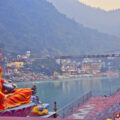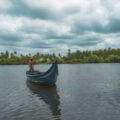If we humanized cities, Kolkata would be a gracefully aging lady who chooses to remain immortal. She reveals just enough of her past to keep you enchanted, intrigues you with her secrets, and comforts you with her warm embrace.
The city we know today was originally a conglomeration of three villages namely, Kalikat, Gobindapur, and Sutanuti dating back to the 13th century. Recognizing their strategic importance as trading posts, the British in 1772 decided to agglomerate them and made Kolkata (then called Calcutta) their capital.
As an important trading center, it has seen many cultures pass through its shores. The traders & colonizers who shaped its topography, the literary giants who penned masterpieces around it and the social reformers who pioneered political movements from here; all have contributed to its unique identity.
The city today is a testimony to these diverse influences which have molded its social, political, and architectural fabric.
With such a rich history to trace, there is never a shortage of things to see and do in Kolkata.
For the avid traveler, here’s a list of unique and must-see places in Kolkata that regales you with its glorious past.

Inherited opulence at the Marble Palace
Location: 46, Muktaram Babu Street
Built-in 1835 by Raja Rajendra Mullick, the Marble Palace can be best described as a hoarders museum. The palace, built in Neoclassical style with Corinthian columns along with its art collection, sums up this wealthy merchant’s love for all things regal.
It houses his vast collection of paintings, victorian furniture, and random curios, collected during his travels.
Although the palace is still a private residence, guided tours are on offer for those curious about finding more.
Photography is, however, not allowed inside the Marble Palace.
Potters’ trail at Kumortuli
Location: Around Banamali Sarkar Street, Kumortuli
No visit to Kolkata can be complete without a walk through Kumortuli – a potter’s colony in North Kolkata.
Here, artists from all over the state converge to create artworks made from clay, bamboo and hay, much the same traditional way.
Although potters of Kumortuli make many different types of idols, it is usually abuzz with frenzied activity a few months before the Durga Puja and Saraswati Puja festivals in Kolkata.
This is when it is teeming with artisans breathing life into clay by turning them into revered figurines which are then intricately painted and decorated.

The religious mosaic of Pareswanath Jain Temple
Location: Belgachia
A marble temple adorned with glass mosaics, multi-colored stones, a well-maintained garden with fountains and European statues, seems like a utopian dream. A visit to the Pareswanath Jain Temple is, therefore, a revelation.
Built-in 1867 by Ray Badridas Bahadur, the main temple is dedicated to Lord Pareshnath, the 23rd Jain Tirthankar. The lamp in its sanctum sanctorum is said to be continuously burning since its inception.
The entire temple complex serves as an oasis of calm for the wandering mind and soul.
The city of the dead at South Park Street Cemetary
Location: 52, Park Street, Opp Assembly of God Church
Just off the eclectic Park Street lies a European necropolis opened in 1767.
With its ornamented tombstones and obelisks built in Gothic and Indo-Saracenic styles, the South Park Street Cemetry is considered to be one of the earliest cemeteries not connected to a Church.
The cemetery is the resting place for many famous Europeans of the time including Sir William Jones, founder of the Asiatic Society.
A walk through the grounds with its overgrown flora encroaching over crumbling tombs can be hauntingly beautiful.

A magical world inside the Indian Museum
Location: 27, Jawaharlal Nehru Road, Park Street
Even if museums are not your forte, one visit to the Indian Museum on Chowranghee and you might just reconsider.
Founded in 1814 by Dr. Nathaniel Wallich, it is one of the oldest museums in the world and the largest in Asia.
A repository of rare antique collectibles, ornaments, and armors, and also houses a 4000-year old Egyptian mummy, medieval paintings and relics of the Buddha.
With six sections covering Art, Archaeology, Anthropology, Zoology, Geology, and Botany; it is bound to capture the attention of the young and the old.
Tagore’s abode at Jorasanko Thakur Bari
Location: Ganesh Talkies, 267, Rabindra Sarani, Singhi Bagan, Jorasanko
While buildings add aesthetics to a city, its people add character. This is evident in Kolkata where legends such as Rabindranath Tagore practiced their art.
A visit to Jorasanko Thakur Bari in Jorasanko, therefore, warrants a place in any Kolkata itinerary.
It was at this ancestral home of the Tagore family that India’s most prominent literary genius was born, spent most of his childhood, and finally breathed his last.
The 18th-century house is now a part of the Rabindra Bharti University that includes the Rabindra Bharati Museum.
History on wheels with a tram ride
Location: Any tram stops. The longest route is between Gariahat and Howrah Bridge
While you are sightseeing in Kolkata, why not experience a tram ride? The only city in India where you can do so!
The trams of Kolkata are the oldest operating electric tram system in Asia, with its origins dating back to 1902.
For a relatively luxurious and comfortable ride, hop on to the Heritage Tram that begins from the Esplanade and glides through the charming northern parts of the city.
However, for an authentic local experience of riding the trams of Kolkata, join the residents on one of their daily commuter trams through the cities bustling inner roads.

Now, before you book that ticket to Kolkata, a recommended pre-visit read is Dominique Lapierre’s novel, ‘The city of Joy.’ A riveting book about the city’s underbelly, it is sure to unveil a range of emotions within you.
Kolkata is something similar. A city of sharp contrasts, it can be overwhelming and calming at the same time. But Kolkata can never be dull.
Image Courtesy: Pixabay, Unsplash, and Author






4 Comments
Vijayendra
Excellent experience
usfman
If you could compare Kolkata to Delhi, what you say is the main difference? I would love to return with my wife to India for more of a spiritual journey.
Ticker Eats The World
I feel they are two completely different place altogether and it would be unfair to compare them. As someone who was born and brought up in Delhi, I find Kolkata fascinating because of the difference in food, the teams, and the heritage aspect of it. Not sure how impactful it is throughout the year in terms of spirituality, except maybe during Durga Puja. For that, I’d recommend Varanasi.